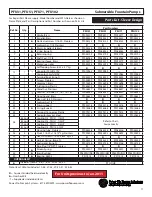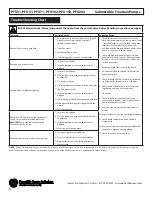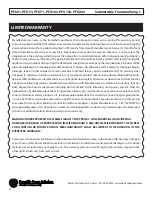
8
Power-Flo Pumps & Systems • 877-24PUMPS • www.powerflopumps.com
Pre-Operation
1. Check Voltage and Phase
Compare the voltage and phase
information stamped on the pump
name plate.
2.
Check Pump Rotation
- Improper
motor rotation can result in poor
pump performance and can damage
the motor and/or pump. Check
rotation on three phase units by
momentarily applying power and
observe the “kickback”. Kickback
should always be in a counter-
clockwise direction as viewed
from motor end or opposite to
impeller rotation. Incorrect rotation
for Single-Phase pumps is unlikely.
If the rotation is incorrect contact
factory.
3.
Name Plate
- Record the information
from the pump name plate to
drawing in front of manual for future
reference.
4.
Insulation Test
- An insulation
(megger) test should be performed
on the motor. Before the pump is put
into service. The resistance values
(ohms) as well as the voltage (volts)
and current (amps) should be
recorded.
Maintenance
No lubrication or maintenance is required.
Perform the following checks when pump
is removed from operation or when pump
performance deteriorates:
a). Inspect motor chamber for oil level
and contamination.
b). Inspect impeller and body for
excessive build-up or clogging.
c). Inspect and clean screen if required.
d). Inspect seal for wear or leakage.
Servicing
NOTE: Item numbers in ( ) refer to Figures
3 & 4.
WARNING ! - Before any service
work is done, disconnect and
lock out electrical power to
pump.
Cooling Oil -
Anytime the pump is
removed from operation, the cooling oil
in the motor housing should be checked
visually for oil level and contamination.
To check oil, set unit upright. Remove
pipe plug (32). With a flashlight, visually
inspect the oil in the housing tube (27)
to make sure it is clean and clear, light
amber in color and free from suspended
particles. Milky white oil indicates the
presence of water. Oil level should be
above all internal componentry.
Oil Testing
• Drain oil into a clean, dry container by
placing pump on it’s end, remove pipe
plug (32), from housing tube (27).
• Check oil for contamination using an
oil tester with a range to 30 Kilovolts
breakdown.
• If oil is found to be clean and
uncontaminated (measuring above
15 KV. breakdown), refill the housing.
• If oil is found to be dirty or contaminated
(or measures below 15 KV. breakdown),
the pump must be carefully inspected for
leaks at the shaft seal (8), gland nut (17),
o-rings (23), and pipe plug (32), before
refilling with oil. To locate the leak,
perform a pressure test.
After leak is repaired, dispose of old oil
properly, and refill with new oil.
Oil Replacement
- Set unit upright and
(drain oil, if not already done), refill with
new cooling oil as per table below.
An air space must remain in the top of
the housing tube when pump is placed
with volute end on bench, to compensate
for oil expansion. Fill until capacitor is
covered when viewing through fill plug
hole. When refilling with oil after servicing
the shaft seal (8), a pressure test should
be preformed. If shaft seal (8) was not
serviced, then apply pipe sealant and
replace the pipe plug (32).
DO NOT
overfill oil. Overfilling
of housing with oil can create
excessive and dangerous hydraulic
pressure which can destroy the
pump and create a hazard.
Overfilling oil voids warranty.
Cooling Oil
Recommended Supplier/Grade
BP
Enerpar SE100
Conoco
Pale Paraffin 22
Mobile
D.T.E. Oil Light
Shell Canada
Transformer-10
Texaco
Diala-Oil-AX
Pressure Test -
Oil should be at normal
level. Remove pipe plug (32) from housing
end (19). Apply pipe sealant to pressure
gauge assembly and tighten into hole.
Pressurize housing to 6 P.S.I. Use soap
solution around the sealed areas and
inspect joints for “air bubbles”. If, after
five minutes, the pressure is still holding
constant, and no “bubbles” /oil seepage
is observed, slowly bleed the pressure
and remove the gauge assembly. Replace
pipe plug using sealant. The leek must be
located and repaired if pressure does not
hold.
Pressure builds up extremely
fast, increase pressure by
“TAPPING” air nozzle. Too much
pressure will damage seal.
DO NOT exceed 6 P.S.I.
Pre-Operation & Service
PFU31, PFU51, PFU71, PFU102, PFU152, PFU202
Submersible Fountain Pumps






























